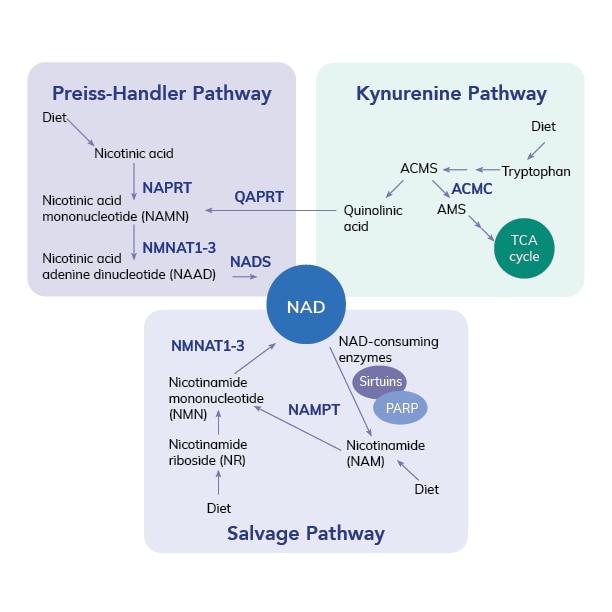Aging Gracefully:
Harnessing NAD+ for Healthy Aging
Table of Contents
1.Introduction
2.Definition and Mechanisms of NAD+
3.The Making of NAD+
4.NAD+ and Implications for Health and Aging
5.Approaches to Restore NAD+
6.Nutrient Solutions to Restore NAD+ and Cellular Health
7.Pure Encapsulations Nutrient Solutions
8.Summary
9.Resources
Introduction
In the intricate world of cellular metabolism, one molecule stands out for its pivotal role in energy production, cellular function, and healthy aging: Nicotinamide adenine dinucleotide, or NAD+. As a coenzyme, it plays a crucial role in facilitating redox reactions and serves as a mediator for vital cellular functions — adjusting to metabolic demands of the cell as needed.
Definition and Mechanisms of NAD+
NAD+ is ubiquitous in every living cell and is found in pools within the cytoplasm, mitochondria and nucleus. Operating primarily as a coenzyme, NAD+ facilitates enzymatic reactions that involve transferring hydrogen atoms in oxidation-reduction processes.[1] In its reduced form, known as NADH, it acts as an antioxidant, playing a vital role in neutralizing free radicals and protecting cellular structures.1
While a crucial player in redox reactions, NAD+ is also involved in:[2],[3]
- Cellular aging
- Energy metabolism
- DNA repair
- Formation of new mitochondria
- Calcium homeostasis
- Immune regulation
- Circadian rhythm
- Vascular activity
- Gene expression
There are three primary classes of enzymes that utilize NAD+: glycohydrolases, sirtuins and PARPs (poly-ADP-ribose polymerases). In their consumption of NAD+, these three classes of enzymes generate nicotinamide (NAM) as a byproduct, which can be recycled back into NAD+ to help maintain intracellular levels.1 Sirtuins are also key regulators implicated in aging processes, while PARP-1 plays a significant role in DNA repair and cell survival under stress conditions.1,[4]
While these three groups of enzymes rely on NAD+, more than 300 enzymes in the body depend on NAD+ for their activity.1
The Making of NAD+
Due to its high demand, NAD+ must be continuously synthesized, catabolized and recycled in the cell to maintain steady intracellular levels.
Intracellular NAD+ levels are sustained in 3 ways:
- de novo biosynthesis using l-tryptophan via the kynurenine pathway
- de novo biosynthesis via the Preiss-Handler pathway, using dietary sources of nicotinic acid, or nicotinic acid mononucleotide from the kynurenine pathway
- recycling of nicotinamide phosphoribosyltransferase (NAMPT) into NAD+ via the salvage pathway

Image adapted from Paro R, Grossniklaus U, Santoro R, et al. Introduction to Epigenetics [Internet]. Cham (CH): Springer; 2021. Chapter 9, Epigenetics and Metabolism. 2021 Mar 24. Available from: https://www.ncbi.nlm.nih.gov/books/NBK585707/doi: 10.1007/978-3-030-68670-3_9. Creative Commons license.
KEY: Nicotinic acid phosphoribosyltransferase (NAPRT), Nicotinic acid mononucleotide (NAMN), Nicotinic acid adenine dinucleotide (NAAD), Nicotinamide mononucleotide adenylyltransferase (NMNAT1-3), 2-amino-3-carboxymuconate semialdehyde (ACMS), Nicotinamide phosphoribosyltransferase (NAMPT), Nicotinamide mononucleotide (NMN)
These pathways collectively regulate the intracellular levels of NAD+, which are essential for maintaining cellular functions and metabolic balance. Understanding the intricacies of NAD+ synthesis and consumption pathways is essential for exploring strategies aimed at modulating cellular metabolism and promoting health.
NAD+ and Implications for Health and Aging
Maintaining optimal levels of NAD+ is crucial for sustaining tissue and metabolic homeostasis throughout life.
As we age, however, levels of NAD+ naturally decline and many of the enzymes responsible for the degradation and biosynthesis of NAD+ are altered. This can lead to NAD+ degradation exceeding the cells’ capacity for de novo synthesis or efficient recycling and salvage of NAM (nicotinamide).1
The age-associated decline in NAD+ may have implications for overall cellular health and longevity.
Approaches to Restore NAD+
Naturally occurring NAD+ decline and altered NAD+ metabolism have been implicated in various processes associated with aging.1 Decreased NAD+ levels can affect cognitive function and have other unwanted health outcomes that extend to the cardiovascular, endocrine and immune systems.1,3
Approaches to restore NAD+ levels can support health and vitality in the aging patient. ‡

The decline in NAD+ levels associated with aging underscores its importance in healthy aging. By understanding and potentially influencing NAD+ levels, healthcare practitioners can explore new avenues in promoting cellular health and longevity.‡
Nutrient Solutions to Support NAD+ and Cellular Health
Nutrients that enhance the biosynthesis and activity of NAD+ can promote restoration of tissue levels of NAD+ and support overall cellular health. ‡
Resveratrol supports metabolic health by promoting healthy activity of the key enzyme AMP kinase (AMPK)and SIRT1 activity which are positively associated with mitochondrial function.[1],[2],7,8
Nicotinamide riboside chloride (NR) is a precursor of nicotinamide adenine dinucleotide (NAD+), a key driver of cellular energy production.1,[3],[4],[5],[6],[7]‡
Sulforaphane is one of the most effective activators of phase II detoxification, which occurs primarily in the gut and the liver.[8],[9]
Acetyl l-carnitine supports healthy mitochondrial function and cell membrane stability.[10]‡
Alpha lipoic acid is a key component of the metabolic process, alpha lipoic acid produces energy in muscles and directs calories into energy production.[11]
are unique natural metabolites of intestinal bacteria that are produced by commensal microbiota after consuming foods rich in ellagitannins and ellagic acid — major health promoting constituents of pomegranates, nuts and berries. These unique polyphenols undergo metabolism by intestinal bacteria to small, highly absorbable metabolites called urolithins, which mediate the widely acclaimed health benefits of pomegranates and other ellagitannin-rich foods.[12],[13]‡
Pyrroloquinoline Quinone, or PQQ provides B vitamin-like activity with unique antioxidant properties. PQQ supports mitochondrial, neuronal and cellular function, at least, in part, by activation of Nrf2 and antioxidant gene expression. Preliminary research suggests that PQQ promotes mitochondrial biogenesis by targeting SIRT1 and PGC-1α.[14]‡
Pure Encapsulations® Nutrient Solutions
Pure Encapsulations® provides uniquely formulated products made with high-quality, pure ingredients backed by verifiable science to complement your plan of care and support healthy aging in your patients.‡
NR Longevity™: specially designed to target biological processes that decline with age, such as the body’s natural ability to make energy, build new mitochondria and protect cells from oxidative stress.1 Nicotinamide riboside (NR), resveratrol and sulforaphane promote healthy aging by replenishing NAD+, enhancing mitochondrial function and providing antioxidant support, respectively.‡
Suggested use: 2 capsules, 1-2 times daily, with or between meals
RENUAL® enhances mitochondrial renewal to support energy output/energy production Features Mitopure™ Urolithin A to power muscle function, increase cellular energy and promote healthy aging.‡
Suggested use: Take 2 capsules, 1-2 times daily, with or between meals.
Ubiquinol-QH 100mg is the active antioxidant form of CoQ10. It supports the production of ATP for energy, promotes cardiovascular health and provides antioxidant support.‡
Suggested use: Take 1 capsule, 1-2 times daily, with meals.
RevitalAge™ Ultra is a scientifically researched combination of acetyl-l-carnitine (ALC) and alpha lipoic acid (ALA) offered with antioxidant and mitochondrial support cofactors. It promotes healthy aging through mechanisms involving gene expression, mitochondrial function, cellular energy production and antioxidant protection. Also contains Nicotinamide riboside (NR) to promote the synthesis of NAD+, a key driver of cellular energy production‡
Suggested use: Take 2 capsules daily, with meals.
Ultra B-Complex w/PQQ combines essential B vitamins with PQQ to support mitochondrial bioenergetics and function. Also provides alpha lipoic acid and luteolin for enhanced antioxidant and cellular support‡
Suggested use: Take 1 capsule, 1-2 times daily, with meals.
Summary
NAD+ represents not just a coenzyme in redox reactions but a central player in cellular vitality and health. Its decline with age highlights its critical importance in maintaining cellular integrity and function. As research progresses, harnessing the potential of NAD+ may offer promising clinical strategies for enhancing both longevity and quality of life.
Resources
Mitochondrial Health Protocol‡: designed by our clinician partners to help you deliver the most effective care and support for your patients. It includes foundational recommendations for overall health and focused interventions to address common clinical objectives related to mitochondrial function.‡
Drug-Nutrient Interaction Checker: provides valuable information on potential interactions between your patients’ prescriptions, over-the-counter medications and nutritional supplements.
PureInsight™: Our streamlined platform easily collects patient data and provides valuable recommendations to help achieve their health goals.
Virtual Dispensary: our Pure Patient Direct program provides account holders FREE access to our virtual dispensary to help simplify patient sales and reduce in-office inventory.
[1] Covarrubias AJ, Perrone R, Grozio A, Verdin E. Nat Rev Mol Cell Biol. 2021;22(2):119-141. doi:10.1038/s41580-020-00313-x
[2] Ying W. Antioxid Redox Signal. 2008;10(2):179-206. doi:10.1089/ars.2007.1672
[3] Xie N, Zhang L, Gao W, et al. Signal Transduct Target Ther. 2020;5(1):227doi:10.1038/s41392-020-00311-7
[4] Xu W, Li L, Zhang L. Front Physiol. 2020;11:901. doi:10.3389/fphys.2020.00901
[5] Timmers S, et al. Cell Metab. 2011 Nov 2;14(5):612- 228
[6] Ghanim H, et al. J Clin Endocrinol Metab. 2010 Sep;95(9):E1-8
[7] Conze D, Brenner C, Kruger CL. Sci Rep. 2019 Jul 5;9(1):9772
[8] Trammell SA, Schmidt MS, Weidemann BJ, et al. Nat Commun. 2016 Oct 10;7:12948
[9] Janssens GE, Grevendonk L, Perez RZ, et al. Nat Aging. 2022 Mar;2(3):254-263
[10] Chu X, Raju RP. Metabolism. 2022 Jan;126:154923
[11] Clement J, et al. Rejuvenation Res. 2019 Apr;22(2):121-130
[12] Zhang Y, et al. Proc Natl Acad Sci U S A. 1992 Mar 15;89(6):2399-403. 2
[13] Karen-Ng LP, et al. Asian Pac J Cancer Prev. 2011;12(5):1161-6
[14] Kerner J, et al. Mech Ageing Dev. 2015 Jan;145:39-50
[15] Kishi Y, et al. Diabetes. . 1999 Oct;48(10):2045-51
[16] Espín JC, Larrosa M, García-Conesa MT, Tomás-Barberán F. Evid Based Complement Alternat Med. 2013;2013:270418
[17] Heim KC. In: Antioxidant Polymers: Synthesis, Properties, and Applications. Cirillo G, Iemma F, eds. Taylor and Francis, c. 2012
[18] Harris CB, et al. Nutr Biochem. 2013 Dec;24(12):2076-84







